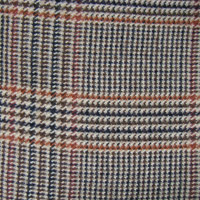Tweed
Tweed is a rough, woolen fabric, of a soft, open, flexible texture, resembling cheviot or homespun, but more closely woven. It is usually woven with a plain weave, twill or herringbone structure. Colored twists of wool are often woven into the fabric to create a heathered or mottled appearance. Traditionally used for upper-class country clothing like shooting jackets, tweed is now used in a variety of apparel, including outerwear, trousers, and suits, as well as in interiors and for upholstery.
History
The origins of tweed are rooted in the Scottish Highlands, where it was developed as a durable and weather-resistant fabric for the farmers and outdoor workers. The name "tweed" is believed to have come about as a misreading or misinterpretation of the Scottish word "tweel," which is the Scots word for twill, the fabric's traditional weave. Another theory suggests the name comes from the River Tweed that flows through the Scottish Borders textile area. The fabric gained popularity in the 19th century when members of the British aristocracy began wearing it for hunting and outdoor sporting activities.
Manufacturing Process
The manufacturing of tweed involves several steps, starting with the dyeing of raw wool, then spinning it into yarn. The wool can be dyed in various colors before it is spun to create intricate patterns and colors in the finished fabric. After spinning, the wool yarn is woven into tweed on looms. The woven tweed is then finished through a process called 'waulking', which cleans, thickens, and shrinks the fabric, enhancing its texture and durability.
Types of Tweed
Several types of tweed have evolved, each with unique characteristics:
- Harris Tweed: Handwoven by the islanders at their homes in the Outer Hebrides of Scotland, made from pure virgin wool dyed and spun in the Outer Hebrides.
- Donegal Tweed: Originating from County Donegal in Ireland, known for its heavy weight and incorporation of multicolored flecks.
- Shetland Tweed: Made from the wool of Shetland sheep, lighter and softer than other tweeds.
- Herringbone Tweed: Characterized by its distinctive V-shaped weaving pattern.
- Check Tweed: Features a checkered pattern, often in earthy tones.
Uses
Tweed has been traditionally used for outdoor activities such as hunting and shooting due to its durability and resistance to harsh weather. However, its use has expanded over time to include casual and formal attire, such as suits and jackets, as well as in home decor and upholstery. Its versatility and timeless appeal have made it a staple in both men's and women's fashion.
Cultural Significance
Tweed is more than just a fabric; it represents a blend of tradition and style that has transcended its rural origins to become a symbol of sophistication and elegance. It is associated with the British country gentry and the Ivy League style in the United States, embodying a classic, understated fashion sense. The fabric also plays a significant role in Scottish heritage and economy, particularly through the production of Harris Tweed, which is protected by law to ensure its authenticity and quality.
Transform your life with W8MD's budget GLP-1 injections from $125.
W8MD offers a medical weight loss program to lose weight in Philadelphia. Our physician-supervised medical weight loss provides:
- Most insurances accepted or discounted self-pay rates. We will obtain insurance prior authorizations if needed.
- Generic GLP1 weight loss injections from $125 for the starting dose.
- Also offer prescription weight loss medications including Phentermine, Qsymia, Diethylpropion, Contrave etc.
NYC weight loss doctor appointments
Start your NYC weight loss journey today at our NYC medical weight loss and Philadelphia medical weight loss clinics.
- Call 718-946-5500 to lose weight in NYC or for medical weight loss in Philadelphia 215-676-2334.
- Tags:NYC medical weight loss, Philadelphia lose weight Zepbound NYC, Budget GLP1 weight loss injections, Wegovy Philadelphia, Wegovy NYC, Philadelphia medical weight loss, Brookly weight loss and Wegovy NYC
|
WikiMD's Wellness Encyclopedia |
| Let Food Be Thy Medicine Medicine Thy Food - Hippocrates |
Medical Disclaimer: WikiMD is not a substitute for professional medical advice. The information on WikiMD is provided as an information resource only, may be incorrect, outdated or misleading, and is not to be used or relied on for any diagnostic or treatment purposes. Please consult your health care provider before making any healthcare decisions or for guidance about a specific medical condition. WikiMD expressly disclaims responsibility, and shall have no liability, for any damages, loss, injury, or liability whatsoever suffered as a result of your reliance on the information contained in this site. By visiting this site you agree to the foregoing terms and conditions, which may from time to time be changed or supplemented by WikiMD. If you do not agree to the foregoing terms and conditions, you should not enter or use this site. See full disclaimer.
Credits:Most images are courtesy of Wikimedia commons, and templates, categories Wikipedia, licensed under CC BY SA or similar.
Contributors: Prab R. Tumpati, MD






